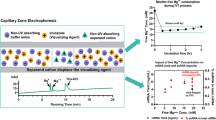Abstract
A reverse-transcription real-time PCR (RT–qPCR) procedure, targeting the phosphatidylcholine-specific phospholipase C (pc-plc) mRNA, was developed for the specific detection and quantification of viable Bacillus cereus. Initial experiments focused on evaluating the performance of various RNA extraction kits and optimizing the DNase I digestion. After optimization, RNA from B. cereus was isolated, and following DNase treatment, the RNA was amplified by RT–qPCR. The assay was used to construct a calibration curve from purified RNA of B. cereus CECT 148T, and it had a wide quantification range of 5 log units. The detection limit was 30 CFU per reaction and the efficiency 0.88. When the developed methodology was applied in artificially contaminated liquid egg, the detection limit was found to be 850 CFU per reaction or 1.1 × 104 CFU per mL of food sample without an enrichment step. To the best of our knowledge, this is the first time that an assay for the detection and quantification of viable B. cereus in food has been described.
Similar content being viewed by others
References
European Food Safety Authority (2007) The community summary report on trends and sources of zoonoses, zoonotic agents, antimicrobial resistance and foodborne outbreaks in the European union in 2006. EFSA J 130:3–352
Fricker M, Messelhausser U, Busch U, Scherer S, Ehling-Schulz M (2007) Diagnostic real-time PCR assays for the detection of emetic Bacillus cereus strains in foods and recent food-borne outbreaks. Appl Environ Microbiol 73:1892–1898
Dierick K, Van Coillie CE, Swiecicka I, Meyfroidt G, Devlieger H, Meulemans A, Hoedemaekers G, Fourie L, Heyndrickx M, Mahillon J (2005) Fatal family outbreak of Bacillus cereus-associated food poisoning. J Clin Microbiol 43:4277–4279
Van Netten P, van de Moosdijk A, van Hoensel P, Mossel DAA, Perales I (1990) Psychrotrophic strains of Bacillus cereus producing enterotoxin. J Appl Bacteriol 69:73–79
Berkeley R, Heyndrickx M, Logan N, De Vos P (2002) Bacillus cereus and food poisoning. In: Granum PE (ed) Applications and systematics of Bacillus and relatives. Blackwell Publishing, Oxford, pp 37–46
Martínez-Blanch JF, Sánchez G, Garay E, Aznar R (2009) Development of a real-time PCR Assay for detection and quantification of enterotoxigenic members of Bacillus cereus group in food samples. Int J Food Microbiol 135:15–21
Martínez-Blanch JF, Sánchez G, Garay E, Aznar R (2010) Evaluation of a real-time PCR assay for the detection and quantification of Bacillus cereus group spores in food. J Food Prot 73:1480–1485
Herman L (1997) Detection of viable and dead Listeria monocytogenes by PCR. Food Microbiol 14:103–110
McIngvale SC, Elhanafi D, Drake MA (2002) Optimization of reverse transcriptase PCR to detect viable Shiga-toxin-producing Escherichia coli. Appl Environ Microbiol 68:799–806
Klein PG, Juneja VK (1997) Sensitive detection of viable Listeria monocytogenes by reverse transcription-PCR. Appl Environ Microbiol 63:4441–4448
Cook N (2003) The use of NASBA for the detection of microbial pathogens in food and environmental samples. J Microbiol Methods 53:165–174
Lee JL, Levin RE (2006) Use of ethidium bromide monoazide for quantification of viable and dead mixed bacterial flora from fish fillets by polymerase chain reaction. J Microbiol Methods 67:456–462
Nocker A, Cheung CY, Camper AK (2006) Comparison of propidium monoazide with ethidium monoazide for differentiation of live versus dead bacteria by selective removal of DNA from dead cells. J Microbiol Methods 67:310–320
Pan Y, Breidt F (2007) Enumeration of viable Listeria monocytogenes cells by real-time PCR with propidium monoazide and ethidium monoazide in the presence of dead cells. Appl Environ Microbiol 73:8028–8031
Rudi K, Moen B, Dromtorp SM, Holck AL (2005) Use of ethidium monoazide and PCR in combination for quantification of viable and dead cells in complex samples. Appl Environ Microbiol 71:1018–1024
Wood SL, Waites WM (1988) Factors affecting the occurrence of Bacillus cereus in liquid whole egg. Food Microbiol 5:103–107
Knutsson R, Lofstrom C, Grage H, Hoorfar J, Radstrom P (2002) Modeling of 5′ nuclease real-time responses for optimization of a high-throughput enrichment PCR procedure for Salmonella enterica. J Clin Microbiol 40:52–60
Bustin SA (2002) Quantification of mRNA using real-time reverse transcription PCR (RT-PCR): trends and problems. J Mol Endocrinol 29:23–39
Sharma VK (2006) Real-time reverse transcription-multiplex PCR for simultaneous and specific detection of rfbE and eae genes of Escherichia coli O157:H7. Mol Cell Probes 20:298–306
Gonzalez-Escalona N, Hammack TS, Russell M, Jacobson AP, De Jesus AJ, Brown EW, Lampel KA (2009) Detection of live Salmonella sp. Cells in produce by a TaqMan-based quantitative reverse transcriptase real-time PCR targeting invA mRNA. Appl Environ Microbiol 75:3714–3720
Anonymous (2003) Microbiology of food and animal feeding stuffs -- Protocol for the validation of alternative methods. ISO 16140:2003
Acknowledgments
This work was supported by “Comisión Interministerial de Ciencia y Tecnología” (CICYT) grant AGL2000-1462 and the CECT. J. F. Martínez was the recipient of a Ph. D. fellowship UA-BPD2002, and G. Sánchez is the recipient of a JAE doctor grant both from the “Consejo Superior de Investigaciones Científicas” (CSIC).
Author information
Authors and Affiliations
Corresponding author
Rights and permissions
About this article
Cite this article
Martínez-Blanch, J.F., Sánchez, G., Garay, E. et al. Detection and quantification of viable Bacillus cereus in food by RT–qPCR. Eur Food Res Technol 232, 951–955 (2011). https://doi.org/10.1007/s00217-011-1465-1
Received:
Revised:
Accepted:
Published:
Issue Date:
DOI: https://doi.org/10.1007/s00217-011-1465-1




